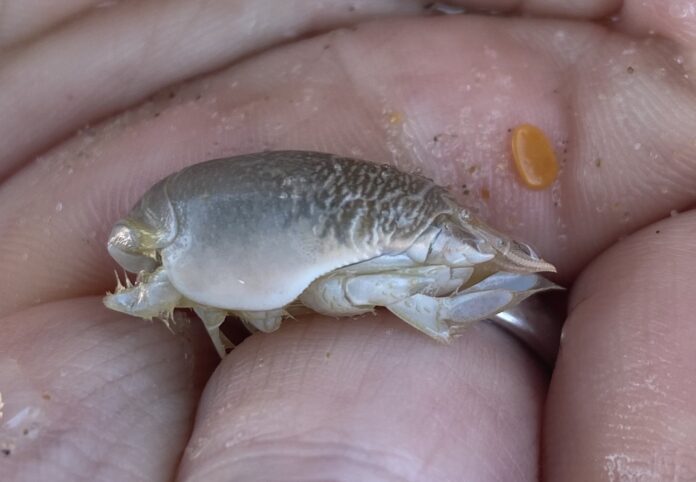BY HARRY WEEKES
This amounts to Part II of my Crab Extravaganza. After this, I will get back to our own ecosystem with questions such as, and I will leave this as a cliffhanger for now, “What’s it like to find a dead deer in your driveway that was not there ten minutes ago?”
Last time, I introduced you to Endo, an Atlantic ghost crab — master scuttler, intrepid hole digger, and eye-stalked denizen of the spray zone. This time, I want you to meet Endo’s cousin — the Atlantic sand crab, a.k.a. the mole crab.
About the only thing Endo and the mole crab have in common is the first part of their common name — Atlantic. OK, OK, that’s not true. Taxonomically, they are both crustaceans, they are both decapods, and they live within about 5 feet of each other in the sands of the Outer Banks (and beyond).
Outside taxonomy (and all that it implies), the dissimilarities I am talking about are how one encounters these beasts.
This is how you come across a mole crab. Find that magical place in the middle tidal zone. This is the area where almost every 4-10-year-old stands, giddily awaiting the waves, then sprints to avoid the rushing water. It is also that place where, if you stand, the wave action moves in, changes the physicality of the sand, and you sink in what has become quicksand. The sand here gets “fluidized” — moving from solid to liquid and then returning to solid.
If you pay attention to your feet in this scenario, which you invariably do, you might giggle a bit from the tickling of the sand moving in and around your toes. You also might jerk a bit when you feel something decidedly not sand move around your feet.
If this happens, you have found the mole crab. Or, rather, it has found you.
When I felt the telltale movements, I knew I was in the right spot. As the next wave washed out to sea, I plunged both my hands into the fluidized beach and scooped up. No fewer than 20 little animals shot down and out in every direction, with one going right into my fingers, where he, or she, stopped immediately. There I was, face to antennae with the Atlantic sand crab.
I placed the little beast on the beach and watched. It sat there (stood?) until a wave came in and at the proper fluidization, disappeared into the sand.
Each time I dug my hands in, I came up with a dozen crabs. Looking up and down the beach, which was sand as far as I could see, I estimated the population to be about 6 gillion.
When I caught a particularly hefty one, I had the natural thought, “Can you eat these?” Deciding to leave snacking until later, I simply marveled at this little creature who, I learned, digs in backwards, leaving its front legs, antennae, and eyes facing out where they can filter food from the surging surf.
The mole crab conducts all elements of its life in a transient zone, in a transient state of matter, sifting through the debris brought to it by the sea. I love anthropomorphizing in cases like this, wondering what this Great Crab Civilization must be like, predominantly because it helps cast my own behavior in a different light. Up and down the beach, here is this one guy, jamming his hands into the shore, giggling into fistfuls of sand.
Then, he stares — two aliens, face to face, each asking the same question: “What’s up with this guy?”



